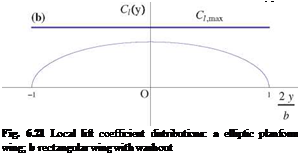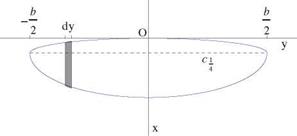Local and Global Lift Coefficients
As seen earlier, the local lift coefficient is related to the local circulation by
Substitution of the circulation in the formula for the global lift coefficient and choosing Aref = S yields
The global lift coefficient is the area weighted average of the local lift coefficient. In particular, if Ci (y) = const. the global lift is equal to the local lift coefficient, Cl = Ci. This is the case for the ideal wing with elliptic planform. For the ideal wing with rectangular planform, the local lift coefficient is elliptic and given by
These distributions are shown in Fig. 6.21 for the two wings having the same Cl.
 |
|
Here we have assumed that the wings are equipped with the same profile. If, at the operating Reynolds number, the profile lift curve has a maximum lift coefficient Ci, max, one can speculate that the elliptical wing will see stall occurring at once from tip to tip when the effective angle of incidence will reach the incidence of maximum Cl. On the other hand, the rectangular wing will stall first in the root section, where the maximum local lift coefficient is found. From the point of view of airplane design, it is desirable to have the wing stall in the root section first, because tip stall will send the plane into a spiral motion from which it is more difficult to escape. The delta wing of Fig. 6.3b is at higher risk of tip stall.
![]()
|












